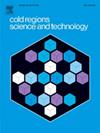Seismic ground motion study of layered site of saturated frozen soil under P-wave incidence
IF 3.8
2区 工程技术
Q1 ENGINEERING, CIVIL
引用次数: 0
Abstract
A two-dimensional model of layered saturated frozen soil over bedrock is developed based on porous media theory, focusing on the seismic response to P-wave incidence. The governing equations for saturated frozen soil are formulated and decoupled using the Helmholtz vector decomposition theorem, yielding a general solution for the potential function. Through the application of the transfer matrix method and interface boundary conditions, an analytical solution for surface displacement in saturated frozen soil is derived. This solution is validated against existing literature. The study comprehensively examines the effects of incident frequency, angle, the surface layer's porosity, medium temperature, cementation parameter, contact parameter, soil stiffness, and surface layer thickness on the seismic response. The key findings are as follows: A layered foundation model demonstrates the seismic effects of stratification on ground motion. Compared to uniform foundations, layered models better represent real-world conditions and reveal the amplification and frequency-dependent characteristics of soil stratification under the idealized analytical framework of this study. For constant incident frequency or medium temperature, the peak horizontal displacement amplification factor is higher in an upper-soft and lower-hard foundation compared to an upper-hard and lower-soft foundation. Horizontal and vertical displacement amplification coefficients exhibit periodic fluctuations with variations in soil thickness. High-frequency seismic waves induce pronounced fluctuations in the horizontal displacement amplification coefficient. Under the idealized analytical framework, the vertical displacement amplification coefficient tends to exceed the horizontal one across all frequencies. These findings provide theoretical insights but require validation through field measurements and numerical simulations to assess their applicability to real-world conditions.
求助全文
约1分钟内获得全文
求助全文
来源期刊

Cold Regions Science and Technology
工程技术-地球科学综合
CiteScore
7.40
自引率
12.20%
发文量
209
审稿时长
4.9 months
期刊介绍:
Cold Regions Science and Technology is an international journal dealing with the science and technical problems of cold environments in both the polar regions and more temperate locations. It includes fundamental aspects of cryospheric sciences which have applications for cold regions problems as well as engineering topics which relate to the cryosphere.
Emphasis is given to applied science with broad coverage of the physical and mechanical aspects of ice (including glaciers and sea ice), snow and snow avalanches, ice-water systems, ice-bonded soils and permafrost.
Relevant aspects of Earth science, materials science, offshore and river ice engineering are also of primary interest. These include icing of ships and structures as well as trafficability in cold environments. Technological advances for cold regions in research, development, and engineering practice are relevant to the journal. Theoretical papers must include a detailed discussion of the potential application of the theory to address cold regions problems. The journal serves a wide range of specialists, providing a medium for interdisciplinary communication and a convenient source of reference.
 求助内容:
求助内容: 应助结果提醒方式:
应助结果提醒方式:


